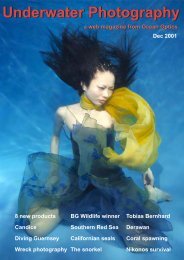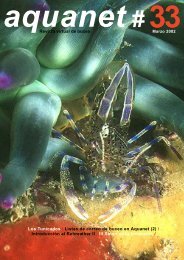Underwater Photography - SENSACIONES.org
Underwater Photography - SENSACIONES.org
Underwater Photography - SENSACIONES.org
You also want an ePaper? Increase the reach of your titles
YUMPU automatically turns print PDFs into web optimized ePapers that Google loves.
increase backscatter from the flash to<br />
unacceptable levels. This is the classic<br />
conundrum that drives people to their<br />
credit cards! The accepted solution<br />
is to add a wide-angle accessory lens<br />
and a strobe or two on long arms,<br />
where they are able to illuminate the<br />
subject without illuminating particles<br />
in the water and causing backscatter.<br />
This solution really works, but it<br />
comes at a hefty price and your<br />
compact camera will no longer be…<br />
well compact.<br />
The alternative approach is to<br />
switch off your flash and try a filter.<br />
It is a different way of shooting and<br />
requires learning how to set the white<br />
balance on your camera, but to me<br />
this seems a small price to pay in<br />
return for the transformation it makes<br />
to your images. For these tests I used<br />
a Magic Filter, which would have cost<br />
me just £19, although actually for me<br />
it was free for reasons disclosed in<br />
UWP 26! This filter was designed for<br />
use with DSLRs, but works very well<br />
on compact digitals too, as long as<br />
they have a manual, custom or preset<br />
WB setting. To attach it to the camera<br />
I just taped it to the front of the lens,<br />
which took about 2 seconds, and slid<br />
the camera into the housing.<br />
The first advantages you will<br />
notice with the filter are that the<br />
battery life of your camera is greatly<br />
improved and you won’t get any<br />
condensation problems, which are<br />
www.uwpmag.com<br />
An alternative approach is to switch off<br />
your flash and try a filter<br />
caused by the internal flash heating<br />
up the inside of the housing when it<br />
fires. But what is really remarkable<br />
are the types of images you can now<br />
take. To shoot wider scenes you just<br />
back away a bit (as you would on<br />
land) to fit in the scenery you want,<br />
and because you are not using strobes<br />
you do not have to worry about flash<br />
fall off and backscatter. OK, there is a<br />
limit to how far you can back away - a<br />
good rule of thumb is to never shoot<br />
from further than 20% of the visibility<br />
(so in 10m/30ft viz, you can back off<br />
to 2m or 6ft). But in reasonable diving<br />
conditions you will be able to shoot<br />
reefscapes, schools of fish, features of<br />
wrecks and divers. In full colour.<br />
The main technique you will<br />
have to learn is how to set the white<br />
balance of your camera manually, so<br />
that the filter will produce the best<br />
results over a range of depths. The<br />
details of setting the white balance<br />
The tiny S3 was able to capture this<br />
reef and diver scene in available light<br />
without the need for bulk accessories<br />
(depth 9m). Nikon S3 + Magic<br />
Filter. 1/25 th @ F3. White balance set<br />
manually. No flash<br />
vary from camera to camera, but<br />
basically involve taking a test shot<br />
of the reef at the depth you want to<br />
photograph and the camera does the<br />
rest and calibrates the WB from that.<br />
This only takes a couple of seconds<br />
once you have practiced it and when<br />
it is done you can snap away as if<br />
you were shooting on land, getting<br />
colourful shot after colourful shot.<br />
It is worth bearing in mind that<br />
you will need to shoot with the sun<br />
coming from behind/above you to<br />
The magic of a filter. Taken at a depth<br />
of 11m an available light shot is simply<br />
recorded in shades of blue. But with the<br />
addition of a filter a digital camera can<br />
record a colourful scene without flash.<br />
Nikon S3 + Magic Filter. 1/15 th @ F3.<br />
White balance set manually.<br />
illuminate the subject evenly and<br />
secondly you need to have good<br />
buoyancy skills so you can hold the<br />
camera still to avoid blurry images.<br />
Also filters tend to work best at<br />
shallower depths above 15m/50ft, so<br />
this isn’t a technique for deeper dives.<br />
On the plus side auto exposure and<br />
autofocus will take care of everything<br />
and images are point and shoot simple<br />
29/45

















